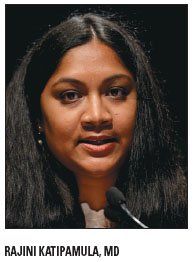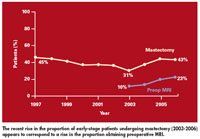Mastectomy rates for early breast cancer are on the upswing at one Mayo Clinic
Mastectomy rates have been on the upswing at the Mayo Clinic in Rochester, Minnesota, and researchers cited MRI as a factor influencing the increase.
ABSTRACT: Increased use of preoperative MRI may play a role, but mastectomy rates also rose in women not undergoing preoperative MRI.

CHICAGO-Mastectomy rates have been on the upswing at the Mayo Clinic in Rochester, Minnesota, and researchers cited MRI as a factor influencing the increase.
“Our study showed that a significant number of women with early-stage breast cancer are undergoing mastectomy, and it appears to be partially related to the introduction of preoperative MRI,” Rajini Katipamula, MD, senior clinical fellow in hematology/oncology, said at ASCO 2008 (abstract 509).
Preoperative MRI identifies an additional 11% to 31% of lesions in the ipsilateral breast and 3% in the contralateral breast, and changes the surgical management in up to one-quarter of cases. To date, there have been no longitudinal data on the association between MRI and mastectomy, according to Dr. Katipamula.
The Mayo study cohort had 5,405 women (5,583 cancers) with stage 0 (DCIS), I, or II breast cancer treated between 1997 and 2006.

In 1997, the mastectomy rate was 45%, but it dropped to 31% in 2003 after lumpectomy was shown to be effective. After 2003, the rate rose again to 43% in 2006, appearing to correspond with the rise in preoperative breast MRI, which also rose from 10% to 23% (see Figure below).
The 2006 mastectomy population included 41% of women with DCIS, 33% with stage I cancer, and 57% with stage II cancer.
Women who underwent preoperative MRI were significantly more likely to have mastectomies
than those who did not. In 2006, mastectomies were done on 51% of women with preoperative MRI (up from 48% in 2003) and in 41% of those without it (up from 29%), she reported.
Over the 4-year period, the average difference in mastectomy rates between patients who underwent MRI vs those who did not was 53% vs 36%, Dr. Katipamula said.
In a multivariate analysis, having preoperative breast MRI raised the odds of undergoing mastectomy by 60% (P = .003). Having surgery in 2006 vs 2003 raised the odds by 70% (P < .0001).
Possible reasons for the increase observed in patients without preoperative MRI include anxiety over having cancer, concern about a personal or family history, better options for reconstruction, and increased awareness of the role of genetics, Dr. Katipamula suggested.